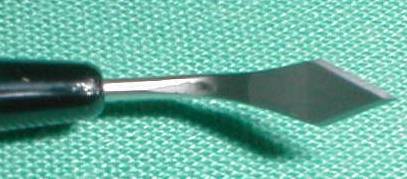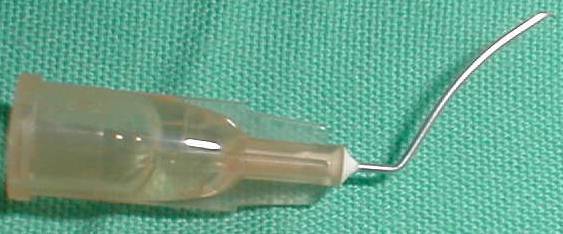Instruments for phacoemulsification
(The following are instruments designed for cataract extraction and
implant. Forceps, viscoelastic and sutures are not shown here.)
|
|

.
 |
Disposable keratome.
This instrument is designed for clear corneal phacoemulsification.
The width of the wound created will allow the entry of the phaco tip without
it being too narrow or too wide. |
|
.
 |
 |
Cystotome needle.
This needle is designed with for easy manipulation in
the anterior chamber. The sharp bent tip is used to tear the anterior capsule
and initiate the capsulorrhexis. |
|
|
|
 ................... ................... |
Utrata forceps.
This forceps has bent sharp tips. It can be used instead
of cystotome needle for capsulorrhexis. Alternatively, it can be used to
pick up the anterior capsular flap created by the cystotome needle to complete
the capsulorrhexis. |
|

Phaco probe |

Phaco needle with sleeve |
Phacoemulsification probe.
The phaco needle is used to emulsify the nucleus. The
sleeve is placed over the needle during phacoemulsification. The sleeve
is incompressible and serves as an insulator. Water which flows
between the sleeve and the needle acts as a coolant and
avoids burnt to the cornea. |
|
 ............ ............ |
There are many designs of nucleus rotator.
The instrument is one of the many types of nucleus rotator.
It can also be used to divide the nucleus. with the help of the phaco tip. |
|
  |
Simcoe irrigation-aspiration cannula.
This instrument is used to remove any cortical material
left after phacoemulsification. It has two ports: one for irrigation to
maintain the anterior chamber and the other for aspiration. It can also
be used to remove viscoelastic material at the end of the surgery. |
|

.
 |
Folding forceps.
This instrument is designed to fold the lens at right
angle and implant it into the capsular bag. |
|
  |
Sinskey hooks. Straight and bent.
The hook is used to dial the haptic into the capsular
bag. |
|